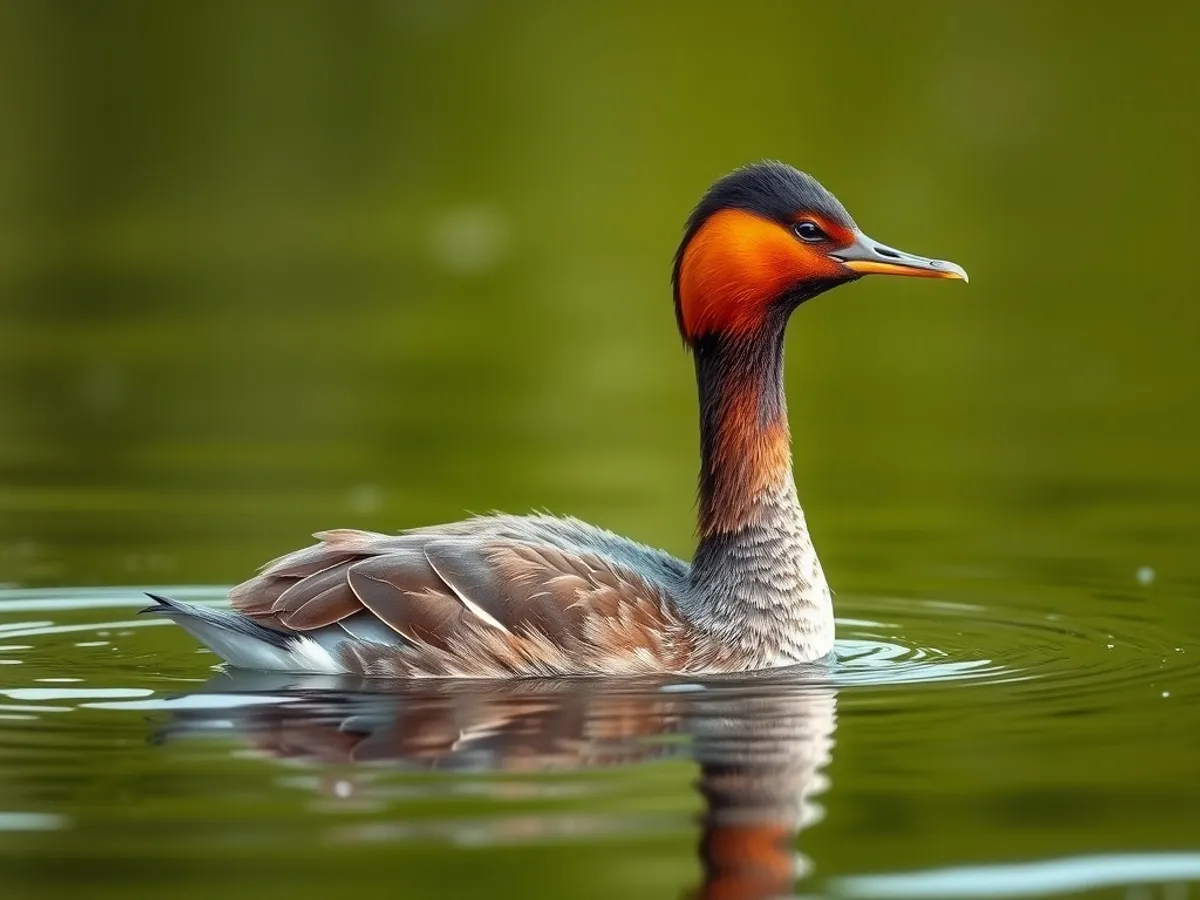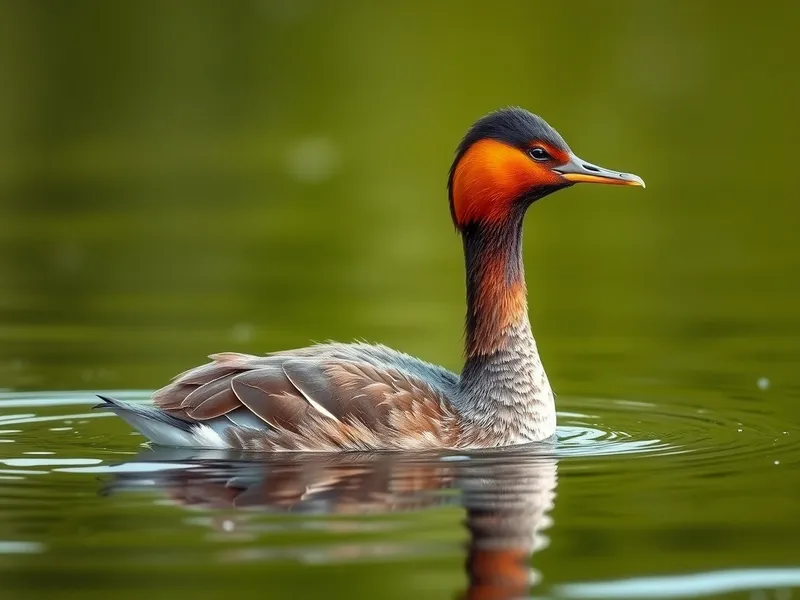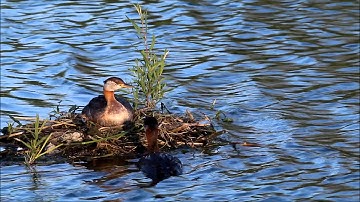
Red-necked Grebe
Podiceps grisegena

Meet the Red-necked Grebe
The Red-necked Grebe is a medium-sized waterbird known for its striking breeding plumage, featuring a chestnut-red neck and sharp, dagger-like bill. It is highly adapted to aquatic life, spending much of its time swimming and diving for prey in freshwater lakes and marshes. During the breeding season, these grebes perform elaborate courtship displays and build floating nests anchored to submerged vegetation. In winter, they migrate to coastal waters, where their plumage becomes duller and less distinctive.
Classification
Bird
Habitat
Freshwater lakes, marshes, and coastal bays
Diet
Carnivore
Lifespan
10-15 years
Conservation
Least Concern
Weight
800-1,600 grams
📖Fascinating Facts
Floating Nests
Red-necked Grebes construct floating nests from aquatic vegetation, anchoring them to reeds or submerged plants to protect eggs from predators and flooding.
Diving Hunters
They are skilled underwater hunters, capturing fish, crustaceans, and aquatic insects with their sharp, pointed bills.
Piggyback Rides
Chicks often ride on their parents’ backs shortly after hatching, allowing them to stay safe and warm while parents forage.
📋Detailed Description
The Red-necked Grebe (Podiceps grisegena) is a robust, medium-sized waterbird, measuring 40–50 cm in length with a wingspan of 77–85 cm and a typical weight range of 700–1,350 grams. In breeding plumage, adults display a striking chestnut-red neck, black cap, white cheeks, and a long, pointed yellow-based bill. Outside the breeding season, their plumage becomes more subdued, with grayish necks and faces, aiding camouflage in winter habitats. Their bodies are streamlined and legs are set far back, making them powerful swimmers and divers but awkward on land. Red-necked Grebes are highly aquatic, rarely venturing onto land except for nesting. Their toes are lobed rather than webbed, a unique adaptation among grebes that enhances propulsion underwater. They are known for their elaborate and synchronized courtship rituals, which include mutual displays, vocalizations, and 'weed dances.' Socially, they are mostly monogamous during the breeding season and territorial, but become more gregarious in winter, often forming loose flocks. Their vocalizations are loud and distinctive, especially during the breeding season, serving both territorial and pair-bonding functions. The species is migratory, breeding in temperate regions of Eurasia and North America and wintering along sheltered coastal waters or large inland lakes.
💡 Did you know?
Unlike many birds, Red-necked Grebes sometimes eat their own feathers to aid in digesting fish bones and other indigestible material.
🔬Research & Sources
Wikipedia Summary
The red-necked grebe is a migratory aquatic bird found in the temperate regions of the northern hemisphere. Its wintering habitat is largely restricted to calm waters just beyond the waves around ocean coasts, although some birds may winter on large lakes. Grebes prefer shallow bodies of fresh water such as lakes, marshes or fish-ponds as breeding sites.
Last Modified: 1/23/2025
🎭Behavior & Social Structure
Red-necked Grebes are diurnal and spend the majority of their time on water, where they exhibit a range of specialized behaviors. They are adept divers, pursuing fish, aquatic insects, crustaceans, and amphibians underwater, often using their sharp bills to spear or grasp prey. Foraging typically involves short, repeated dives, with birds surfacing to swallow food or feed chicks. During the breeding season, pairs defend territories aggressively, using vocalizations and threat displays to deter intruders. Courtship involves complex displays such as mirroring postures, head-shaking, and presenting aquatic vegetation. Outside the breeding season, they are less territorial and may associate in small flocks, especially at rich feeding sites. Daily routines include preening, bathing, and frequent diving, with periods of rest spent floating on the water. They are generally silent in winter but become highly vocal during the breeding season.
👶Reproduction & Life Cycle
Red-necked Grebes are seasonally monogamous, forming pairs each breeding season, which typically begins from April to June depending on latitude. Courtship culminates in the construction of a floating nest, anchored to emergent vegetation in shallow water. Both sexes participate in nest building and incubation. Clutch size ranges from 3 to 5 eggs, which are incubated for 21–33 days. Chicks are precocial, leaving the nest within hours of hatching, and are often carried on the backs of the parents for warmth and protection. Both parents feed and guard the young, which fledge at 45–60 days old. Breeding success is influenced by water levels, predation, and disturbance.
🛡️Adaptations & Survival
Red-necked Grebes possess several adaptations for aquatic life. Their lobed toes provide powerful propulsion underwater, while their dense, waterproof plumage insulates against cold water. The rear placement of their legs enhances diving efficiency but limits terrestrial mobility. Their sharp, dagger-like bills are specialized for catching slippery prey. Behavioral adaptations include floating nests that rise and fall with water levels, synchronized courtship displays to reinforce pair bonds, and the ability to carry chicks on their backs. Their migratory behavior allows them to exploit seasonally abundant resources and avoid harsh winter conditions.
🎨Cultural Significance
Red-necked Grebes have limited direct cultural significance but are valued as indicators of wetland health and biodiversity. In some regions, they feature in local folklore or as subjects in birdwatching and nature photography. Their elaborate courtship displays and striking appearance have made them a favorite among naturalists and bird enthusiasts. There are no known traditional uses or significant roles in mythology.
🔬Recent Research & Discoveries
Recent research has focused on the species' migratory connectivity using stable isotope analysis and satellite tracking, revealing complex migration routes and stopover sites. Studies on vocalizations have highlighted the role of acoustic signals in mate selection and territory defense. Ongoing research examines the impacts of climate change on breeding phenology and habitat selection. Genetic studies have clarified relationships between Eurasian and North American populations, supporting their classification as subspecies (P. g. grisegena and P. g. holboellii). Conservation monitoring continues to assess population trends and the effects of habitat management.
🎥Wildlife Videos

Movie Red-Necked Grebe (Part I )
Movie Red-Necked Grebe (Part I )
Ark Mila

Red-necked Grebe in 4k. GH5S
This beatifuel bird is called Red-necked Grebe (Gråstrupedyker/Gråhakedopping) and it is easy to spot why. Filmed at ...
Steinar Eilerås Nature Films

Incredible Nesting Behavior of Red-Necked Grebes | PhotoWILD Magazine
When most people think of Alaska, I suspect all they see are bears and moose and mountains. For me, however, it's what lies in ...
Jared Lloyd Photography

Red-necked Grebe: oxonbirding.blogspot.co.uk
Red-necked Grebe Farmoor Reservoir Oxon 25/3/15.
megabrock161

Red-necked Grebe, Camber 08/01/2017
Shaun Ferguson

Preening Red-necked Grebes
This pair of Red-necked Grebes appear to be nesting at Crex Meadows, in Grantsburg, Wisconsin.
Laura Erickson
🌍Habitat Information
The Red-necked Grebe typically inhabits Freshwater lakes, marshes, and coastal bays environments. Red-necked Grebes have adapted to their environments with specialized features and behaviors.
Primary Habitat:
Freshwater lakes, marshes, and coastal bays
More detailed habitat information will be available soon.
🛡️Conservation Status
The Red-necked Grebe is currently classified as Least Concern. Conservation efforts are crucial for preserving this species for future generations.
Common Threats:
- 🏠Habitat loss and fragmentation
- 🌡️Climate change impacts
- 🎯Hunting and poaching
- 🏭Human-wildlife conflict
⚠️Threats & Conservation Challenges
While currently listed as Least Concern by the IUCN, Red-necked Grebes face several localized threats. Habitat loss due to wetland drainage, eutrophication, and development can reduce breeding sites. Pollution, especially oil spills and pesticide runoff, poses risks in both breeding and wintering areas. Human disturbance, such as recreational boating and shoreline development, can lead to nest abandonment. Climate change may alter water regimes and affect prey availability. Despite these challenges, global populations are considered stable, though some regional declines have been noted.
🔬Scientific Classification
Scientific Name
Podiceps grisegena
Classification Hierarchy
🔍 About Taxonomic Classification
Taxonomic classification is a hierarchical system used by scientists to classify and organize living organisms based on shared characteristics and evolutionary relationships.
The system moves from broad categories (Kingdom) to increasingly specific ones, with each animal's scientific name typically consisting of its Genus and species.
📝Community Notes
Share your observations and insights about the Red-necked Grebe with our community of wildlife enthusiasts.
Join Our Community
Sign in to share your observations and connect with fellow wildlife enthusiasts.
Sign In to ContributeNo community notes yet
Be the first to share your observations about the Red-necked Grebe!
Explore Red-necked Grebe
Select a tab above to learn more about this amazing animal.
📸Photo Gallery
No photos available for this animal yet.
🌟Discover More Wildlife
Continue your journey of discovery with more fascinating animals from our database
